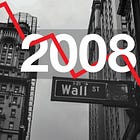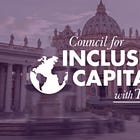Conditional Economics
Ever had a gift card that only works at certain stores or expires after a few months?
Now imagine money itself working like that.
What is ‘Conditional Economics’?
It's when access to money (a loan, investment, or payment) depends on proving you've met specific rules or targets. This system now operates at three levels simultaneously:
National level: Countries seeking funding from the International Monetary Fund (IMF) or World Bank must adopt specific policies to access loans. The modern version uses ‘Results-Based Management’ (RBM — essentially ‘plan, measure, pay’) with Key Performance Indicators (KPIs — numerical targets to hit). For example, Nigeria's $611 million World Bank Program-for-Results for education only releases funding when the country hits specific targets: increasing primary school enrollment rates, improving teacher training metrics, and reducing dropout numbers. Miss your Disbursement Linked Indicators (DLIs)? The money stops flowing.
Corporate level: Companies find their access to capital tied to Environmental, Social, and Governance (ESG — scoring for environmental impact, labor practices, and board governance) criteria and Corporate Social Responsibility (CSR) standards. Italian utility ENEL's €10 billion sustainability-linked loan from a syndicate of banks exemplifies this: their interest rate decreases if they hit renewable energy capacity targets and increases if they miss them. The ‘margin ratchet’ means borrowing costs directly reflect ESG performance.
Individual level: Central Bank Digital Currencies (CBDCs — digital cash issued by central banks) are being designed with technical controls over spending. During China's digital yuan pilots in Shenzhen, citizens received promotional ‘red packets’ worth 200 yuan each, but the money could only be spent at 3,389 designated merchants and expired after one week. The Bahamas' Sand Dollar similarly restricts transactions above certain amounts and requires enhanced verification for larger purchases. These pilots demonstrate how programmable money can limit where, when, and how people spend.
Where This Model Came From
This approach matured in international development aid during the 1970s under World Bank President Robert McNamara. He brought ‘Planning, Programming, and Budgeting System’ (PPBS) methodology from his time as US Defense Secretary, creating the plan-measure-pay model: countries and the Bank agree on measurable objectives, funding releases in stages tied to hitting benchmarks, and payments pause if targets aren't met.
The IMF operates similarly through structural adjustment programs (policy changes required for emergency lending), making crisis lending conditional on implementing specific economic reforms like privatising utilities or reducing government spending.
The Ethics Framework
Institutions frame these conditions around moral imperatives, with their stated rationale focusing on stability, accountability, and risk management:
Environmental Justice: This framework positions financial conditions as necessary responses to climate change and ecological degradation. Specific requirements typically include carbon emission reduction targets, renewable energy adoption quotas, deforestation limits, and pollution control measures. The underlying logic holds that environmental damage imposes costs on society that current economic activities should internalise. Funding becomes conditional on demonstrating measurable environmental improvements or implementing policies designed to prevent ecological harm.
Social Justice: This approach links financial access to addressing inequality and discrimination. Common conditions include diversity hiring targets, wage equity requirements, affordable housing provisions, and anti-discrimination policies. The framework operates on the premise that economic systems should actively counteract historical inequities and ensure fair distribution of resources. Recipients must demonstrate progress on social inclusion metrics to maintain funding eligibility.
Intergenerational Justice: This framework requires present decisions to account for their impact on future generations. Typical conditions involve pension system reforms, infrastructure investments with long-term benefits, education spending commitments, and restrictions on debt accumulation. The principle asserts that current populations bear responsibility for ensuring future generations inherit sustainable economic and social systems. Financial assistance becomes tied to policies that allegedly serve long-term collective interests rather than short-term local preferences.
Packaging financial conditions within these moral frameworks transforms economic requirements into ethical obligations. This framing makes resistance appear irresponsible or immoral, regardless of the specific requirements or enforcement methods involved.
‘You Can Choose... But It Will Cost You’
The system maintains an appearance of choice while making alternatives economically punitive. Countries can reject conditional lending, but typically face higher borrowing costs, credit downgrades, and restricted access to international capital markets. Companies can ignore ESG requirements, but encounter higher financing costs and exclusion from major investment funds.
This design makes compliance effectively mandatory while preserving the facade of voluntary participation. The conditioning becomes inescapable not through explicit prohibition, but through systematic manipulation of economic incentives.
Impact Financing and Programmable Money
The methodology continues expanding through ‘impact investing’ and ‘blended finance’ structures that tie investment returns to achieving specific social and environmental outcomes. Money flows more freely when targets are met, creating financial incentives for desired behaviors across new sectors.
Meanwhile, CBDC infrastructure being developed worldwide includes capabilities for transaction-level conditioning. Early pilots demonstrate money that works only in certain geographic areas, with specific merchants, or within time windows. As digital payment rails become more sophisticated, finer-grained controls become technically feasible.
Moral Economy and Inclusive Capitalism
The conditional economics system described above represents components of a larger transformation toward what advocates call a ‘moral economy’ and ‘inclusive capitalism’. These frameworks propose restructuring economic systems around ethical principles rather than traditional market mechanisms.
A moral economy operates on the principle that market participation should serve broader social and environmental purposes beyond profit maximisation. Economic access becomes contingent on demonstrating alignment with collectively determined moral objectives. This represents the systematisation of conditional economics — where proving ethical compliance becomes prerequisite for full economic participation.
Inclusive Capitalism, promoted by initiatives like the Council for Inclusive Capitalism, proposes redesigning market systems to serve multiple stakeholders rather than primarily shareholders. This framework integrates ESG metrics, social impact measurements, and environmental criteria directly into the structure of economic institutions. Financial flows become organised around achieving predetermined social outcomes rather than purely economic returns.
When combined, these approaches create comprehensive systems where economic participation at every level becomes conditional on demonstrating compliance with centrally defined ethical frameworks.
The consequences for refusal operate systematically across all three levels:
Individual level: Those unable or unwilling to meet conditioning requirements face restricted economic participation. This could manifest as inability to access certain services, geographic movement limitations, or exclusion from optimal transaction terms. Digital payment systems can technically isolate non-compliant individuals from mainstream commerce.
Corporate level: Companies that reject ESG compliance encounter higher borrowing costs, exclusion from major investment funds, restricted access to global supply chains, and potential regulatory penalties. Market mechanisms make non-compliance economically punitive rather than legally prohibited.
National level: Countries refusing conditional financing face credit downgrades, higher sovereign borrowing costs, exclusion from international development programs, and restricted access to global financial markets. Economic isolation becomes the practical consequence of policy independence.
The technical infrastructure for such systems already exists through RBM/KPI monitoring at the institutional level and programmable features in digital currency systems at the individual level. The framework creates systematic economic pressure toward compliance without requiring explicit legal mandates.
Crucially, the moral objectives underlying both frameworks operate outside traditional democratic processes. The ethical criteria determining economic access — from ESG metrics to social justice requirements to environmental standards — are typically established by international organisations, expert panels, and institutional frameworks rather than through direct democratic vote. Citizens, shareholders, and even national governments often find themselves subject to moral standards they had no role in defining.
‘Inclusive Capitalism’, despite its name, functions as an exclusionary system that denies full economic participation to those not aligned with its predetermined criteria. The framework includes only those who demonstrate compliance with its specific interpretation of social and environmental responsibility, while systematically excluding individuals, companies, and countries that reject or fail to meet these externally imposed standards.
Questions Worth Asking
This convergence toward conditional economics raises fundamental questions about economic freedom, democratic governance, and individual autonomy:
Who determines what constitutes ‘responsible’ behavior worthy of economic access?
How do these mechanisms affect national sovereignty and democratic decision-making?
What happens to economic freedom when transactions require external approval?
How do societies balance collective ethical objectives with individual economic autonomy?
The technical capabilities for comprehensive conditional economics now exist. The ethical frameworks justifying their implementation are established and expanding. Understanding how these systems operate across all levels of society becomes essential for evaluating the economic infrastructure currently under development.






It's been around for a while and goes by another name Fascism follow orders or people die
'environmental damage imposes costs on society that current economic activities should internalise'
Which it does. However. These slimy bastards reframe the healing of the environment as them owning/controlling it so they can chop the trees down for wind farms and destroy the forests fir lithium for example.